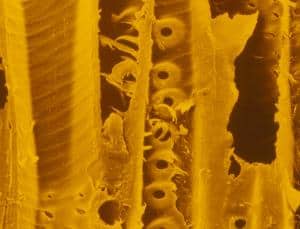
We have been talking about uses of wood… there are some on the research horizon of interest.
Here’s an article from New Scientist.
A battery made from wood doesn’t exactly scream high-tech innovation – more like something cooked up round the campfire. But a device that exploits wood fibre could be the key to cheap, renewable power.
Lithium-based rechargeable batteries are too expensive to use on a large scale because there is so little lithium available. But sodium is abundant and cheap, so why not base a battery on a sodium electrolyte?
The problem is that sodium ions are many times larger than lithium ones, and they gradually damage a battery’s anode as they diffuse during charging and discharging. Another issue is that using a tin anode in such batteries would offer the highest power storage capacity, but this leads to the formation of a sodium-tin alloy that makes the battery swell, hastening what is known as “structural pulverisation”. The upshot is that a sodium-ion battery with a tin anode can only be charged and discharged around 20 times.
To get around this, Hongli Zhu and colleagues at the University of Maryland in College Park turned to a natural material they knew could more easily carry large ions: soft, porous wood fibre. These fibres include hollow elongated cells called tracheids, which have walls made of a tough material called lignin and which transport water and mineral salts around the organism.
Tin on woodBy depositing a 50-nanometre-thick layer of tin on 2500-nanometre-thick wood fibres, the researchers were able to create an anode that could be charged and discharged 400 times.
The relatively soft nature of the wood fibres effectively releases the mechanical stresses that would pulverise an ordinary tin anode, the team says, resulting in “unprecedented performance for a tin-anode sodium-ion battery”. And because wood fibre is easy to process, it should be possible to use it in the manufacture of low-cost batteries.
The team now wants to engineer bigger batteries for use in renewable storage applications.
Bingan Chen, a researcher specialising in novel battery materials at the University of Cambridge, UK, is impressed. “Using wood fibre as a substrate to lower their cost of sodium-ion batteries is a great, innovative idea,” he says. “But their challenge will be working out how to scale up the manufacturing process to make it commercially viable.”
I spent one summer working for a timber company in SW Oregon years ago, and we would find Port Orford Cedars with undercuts in them left in the woods. These trees had rot in the center. I was told they were harvesting the cedars to use the wood as battery separators during WWII. So wood has been used in batteries before.